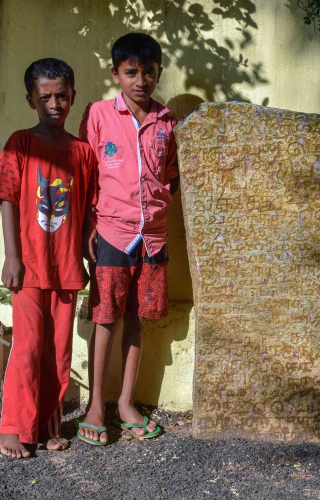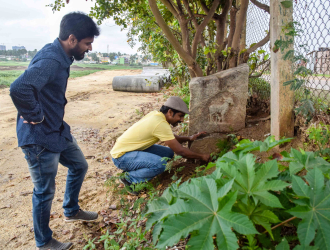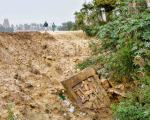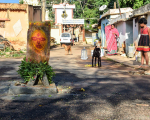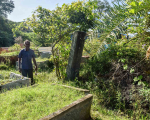Bengaluru has experienced rapid expansion in the last 40 years, which has dramatically changed the landscape of the surrounding countryside. Urbanisation has swept away older settlements, water bodies, natural features, and illegal settlers have encroached upon culturally significant spaces, displacing or destroying many precious heritage artefacts. One such casualty of unrestricted development has been inscription stones.
The Bengaluru urban region had close to 175 inscription stones, but there is record of only about 40 stones presently. I heard of Bengaluru’s inscription stones through my friends, P.L. Udaya Kumar and Vinay Kumar. I was immediately hooked. Udaya and Vinay started the ‘Inscription Stones of Bangalore’ (ISB) project in 2017, and they run an eponymous Facebook group to spread awareness about their conservation work. The group includes well-known epigraphists like Professor K.R. Narasimhan, Dr P.V. Krishnamurthy and historian Dr S.K. Aruni, among others who provide guidance and support at various stages of the project, helping the team locate, identify and decipher inscriptions.
Inscriptions are records of important events in the region; hence, they are important to archaeologists, epigraphists, historians and linguists. In India, inscriptions were recorded either on stone surfaces or on copper plates. Inscriptions are considered as primary evidence in reconstructing historical events and persons. The study of inscriptions (epigraphy) started in India during the colonial period. Between 1894 and 1905, epigraphist Benjamin Lewis Rice (1837–1927), along with other epigraphists, documented more than 9,000 inscriptions in the erstwhile Mysore State. These inscriptions are in a variety of Indian languages, including ancient Brahmi script, Sanskrit, Tamil, Kannada, Telugu and even Persian and Urdu.
B.L. Rice translated and transliterated the inscriptions and published them in a remarkable 12-volume book-series called Epigraphia Carnatica. The 12 volumes were divided according to findings in Kodagu, Sravanabelgola, Mysuru, Hassan, Kadur, Shimoga, Bengaluru, Kolar, Chitaradurga and Tumkur districts. R. Narsimhacharya, who succeeded Rice as the head of the archaeological department, found another 4,000 inscriptions. Further additions were made by M. H. Krishna, after his excavations at Chandravalli and Brahmagiri, where he discovered 2,000 inscriptions and published them as volumes 13, 14 and 15 of Epigraphia Carnatica. Udaya and Vinay, along with other volunteers, retraced the inscriptions based on the references in the Epigraphia Carnatica. So far, close to 40 stones have been identified and verified in the Bengaluru region. A few new stones were discovered recently which were not documented in the Epigraphia Carnatica.
The majority of inscription stones were erected during important occasions, usually on the inauguration of a new temple or completion of an engineering project. The inscriptions on such stones mention the name of the patron, the type of donation made, and the year of consecration. An example is the Kadugodi stone, now lying inside a Whitefield cemetery. The stone belongs to 1043 CE and mentions the great king Rajendra Chola allotting funds and donating land in Pattandur Agrahara to build an artificial lake with three sluice gates. Last year, the information on this inscription stone has been provided to the High Court of Karnataka as a historic proof that the lake has existed for over 950 years, in support of citizen groups who have been protesting illegal encroachment of the lake from land sharks who have turned the heritage water body into a dumping ground.
The other type of stones like sati memorials and hero stones (Virakallu) were erected to honour deceased persons. Sati memorials commemorated married women who performed sati on the death of their husband. Such stones contain the image of the deceased husband and his wife/wives and their ascent to heaven in the afterlife. Virakallu were erected by family members of a warrior who was martyred in battle. Virakallu are more graphic and they depict the narrative of the battle, the nature of the warrior’s death and his veneration of the kuldevta (family deity) after reaching heaven. The inscriptions on such stones mention the brave act of the hero, the battle in which he was slain, and the name of the king under whom he fought. One such Virakallu was discovered in Begur, which records the death of a servant of Nagattara, who died in the Battle of Bengaluru fought in 890 CE. This is the oldest reference to the city’s modern name.
Another very important Virakallu was discovered in Hebbal last year, when the municipal corporation was working on construction of a new road. They wanted to cover the Virakallu that was half-buried on the pavement with concrete. The locals alerted the Heritage Revival Group, led by Rajeev Nrupathunga, who dug out the stone. Everyone was surprised to find very well-preserved inscriptions because the stone was underground for many centuries. This is currently the oldest inscription stone in Bengaluru, dated 750 CE. It speaks about Kittaya, who died in a war saving the erstwhile Perbolalnadu (today’s Hebbal). This makes Kittaya the oldest citizen of Bengaluru/Hebbal who we know by name.
The recovery of the Hebbal stone is a good example of the importance of local communities in safeguarding these stones, provided they are educated about their importance. Some of the stones thus discovered were known in the neighbourhood for generations and venerated as sacred structures. Locals still apply turmeric and kumkum on them and perform puja. However, many stones were also damaged, because locals did not understand what was written on them, hence did not have any value for them. To raise awareness, the ‘Inscription Stones of Bangalore’ team organises talks, seminars, meetups, heritage walks and exhibitions etc. to keep the public informed about these stones. They raised funds to build a mandapa for preservation of the Kittaya stone. With some public and private support, INTACH (Indian National Trust for Art and Cultural Heritage) Bangalore chapter created a pedestal for the Begur Stone and placed it in the Nageshwara Temple complex for safety. The exact location of inscription stones has been marked on Google Maps for anybody interested to visit them. Through these initiatives, the ISB has now become a civic activism project and has made Bengaluru’s citizens an equal stakeholder in the preservation of the city’s history and heritage.
The languages of the inscriptions clearly show the cosmopolitan history of the city and help us understand the changing geo-political history of the region. The information recovered from these inscriptions has changed the historical timeline of Bengaluru, which till recently was believed to have been founded only in the mid-16th century by Kempe Gowda I. As a photographer, for me, the biggest challenge was to create interesting stories out of these stones. I wanted to include human engagement, and when possible, to add living spaces around the stones. I shot the stones over many days, travelling across the length and breadth of the city. I am grateful to fellow heritage lovers at ISB; Udaya and Vinay, professors, historians, epigraphists and fellow citizens, for helping me uncover some of the hidden wonders of the city of Bengaluru.
